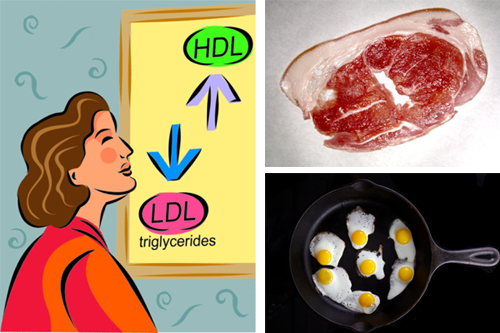Dec 17, 2025
Dec 17, 2025

Cholesterol is a fat-like, steroid alcohol with the chemical structure as C27-H45-OH. It crystallizes to form leaflets or plates from dilute alcohol. It is commonly found in foodstuffs like animal fats and oils. milk, and yolk of eggs. Normal levels of cholesterol in the blood do not cause any disease. It is also present in the bile, brain tissue, liver, kidneys, and adrenal glands.
Prolonged high blood levels of cholesterol in circulation lead to hypercholesterolaemia (Syn. hyperlipidaemia). Earlier the incidence of hypercholesterolaemia was higher in the developed countries, but now an increased incidence has also been recorded in the Third World countries. Perhaps this is due to a change in diet habits and lifestyle associated with development and industrialization. The incidence is also higher in the affluent strata of society compared to the poorer sections of the population.
In the body (liver & kidneys) cholesterol is synthesized from acetate via the basic scheme - Acetate to Mevalonate to Squalene to Lanosterol, and finally to Cholesterol.
In addition, it is absorbed from a fat-rich diet (animal fats & oils, milk, & egg yolk). In the body cholesterol localizes in the cell membranes and is responsible for maintaining its structural integrity. If cholesterol metabolism is defective, the cell membrane ceases to function properly and ruptures easily. The steroid hormones in the body are also derived from cholesterol which provides the basic chemical skeleton.
Lipids exist in the blood as cholesterol and triglycerides, and smaller amounts as phospholipids, fatty acids and fatty acid esters. Free fatty acids (FFA) are bound to plasma albumin, while the other lipids form complexes with proteins (albumin & globulins).
These lipoproteins are classified as: chylomicrons; very low density lipoproteins (VLDL); low density lipoproteins (LDL); and high density lipoproteins (HDL). The particle size sequentially decreases from chylomicrons to HDL. Lately, a receptor mediated control of cholesterol metabolism has been propounded.
Atherosclerosis is a metabolic disorder characterized by faulty transport, distribution, and deposition of lipids in the body. Chronic hyperlipidaemia leads to damage to the innermost layer (endothelium) of the arteries and subsequent formation of atheromatous plaques in the walls of the arteries, leading to their narrowing. This process mainly affects the medium sized arteries, namely, the cerebral (brain), coronary (heart), renal (kidneys), and vertebral (spine) arteries. The resultant clinical complications are: coronary artery disease (Heart attack); hypertension; gall stones; cerebrovascular disease (Stroke); and peripheral vascular disease. The factors leading to hyperlipidaemia include improper diet, excessive alcohol intake, hypothyroidism (thyroid under-activity), diabetes mellitus, or an inherent hereditary trait. Lack of symptoms in the individual until serious complications occur necessitates periodic monitoring of the lipid profiles. The accepted values for working up cases are as under:
| Status | Total Cholesterol | LDL Cholesterol | HDL Cholesterol |
| Desireable Borderline Undesireable |
< 200 mg/dl 200-239 mg/dl > 240 mg/dl |
< 130 mg/dl 130-159 mg/dl > 16 mg/dl |
> 60 mg/dl 35-60 mg/dl < 35 mg/dl |
Raised LDL cholesterol levels predispose the individual to disorders like coronary artery disease, hypertension, stroke, and gallstones. Whereas, a low level of HDL cholesterol (good cholesterol) is also associated with the above mentioned disorders, i.e. HDL has a protective role to play. Lately, a new Harvard University study, based on 100,000 subjects found that HDL (so called good cholesterol) did not effectively lower the risk of a heart attack.
Drugs available to treat hyperlipidaemia include cholestyramine, clofibrate, gemfibrozil, lovastatin, atorvastatin, and simvastatin. However, diet and exercise are the best initial measures to prevent complications of hyperlipidaemia. Diet low in saturated fat with vitamins maintains cholesterol levels within limits. Foods rich in polyunsaturated fatty acids (PUFA) are preferred. Gugulipid, an Indian indigenous drug, safflower oil, and fish oils also have a protective role to play.
Periodic lipid profile check-ups are desirable to avoid complications.
Images (c) Gettyimages.com
01-Oct-2012
More by : Dr. Frank S. K. Barar

|
Yes, studies have shown that consuming GREEN TEA in beverage or powder form reduce both TOTAL and LDL cholesterol. (Health Capsule, Times of India, Sept. 26, 2012). |

|
Liked this artical. Good in terms of information to common people and clears some doubts. |